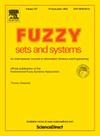基于模糊集的自主导航方法
IF 2.7
1区 数学
Q2 COMPUTER SCIENCE, THEORY & METHODS
引用次数: 0
摘要
提出了一种基于模糊集的自主导航路径遵从和局部避碰方法。它针对的场景是,车辆到达目的地的全局路径已经规划好了,但对环境中的障碍物及其动态情况知之甚少。假设车辆能够对自身和周围的障碍物进行定位,该方法将车辆的全局路径和实时获取的局部障碍物知识结合起来,形成对环境的综合模糊表示。然后利用这种模糊表示来评估车辆状态在平衡全局路径依从性和避障目标的优化框架内的可取性。该优化问题的基于梯度的解决方案使车辆保持其朝向指定目的地的全局路线,同时避免与局部障碍物发生碰撞。在移动机器人上的大量仿真验证了该方法在引导车辆沿着预期路径,以最小偏差绕过障碍物以及无振荡地协商局部最小值方面的有效性。此外,仿真结果表明,基于模糊集的方法计算复杂度低,实时性强,对处理复杂几何形状的路径和障碍物具有适应性。本文章由计算机程序翻译,如有差异,请以英文原文为准。
A fuzzy set-based methodology for autonomous navigation
This paper presents a fuzzy set-based methodology to achieve simultaneous path adherence and local collision avoidance in autonomous navigation. It targets scenarios where a global path to the vehicle's destination is already planned but with imperfect knowledge of the obstacles in the environment and their dynamics. Assuming that the vehicle can localize itself and the obstacles around it, the proposed methodology incorporates the global path and the acquired real-time knowledge of the local obstacles by the vehicle to create a comprehensive fuzzy representation of the environment. This fuzzy representation is then utilized to assess the desirability of the vehicle states within an optimization framework that balances global path adherence and obstacle avoidance objectives. The proposed gradient-based solution to this optimization problem navigates the vehicle such that it maintains its global course toward the designated destination while avoiding collision with local obstacles. Extensive simulations on a mobile robot validate the method's efficacy in guiding vehicles along desired paths, maneuvering around obstacles with minimal deviation from the route, and negotiating local minima without oscillations. Additionally, simulation results highlight the proposed fuzzy set-based methodology's low computational complexity, real-time operation capability, and adaptability in handling complex geometries of paths and obstacles.
求助全文
通过发布文献求助,成功后即可免费获取论文全文。
去求助
来源期刊

Fuzzy Sets and Systems
数学-计算机:理论方法
CiteScore
6.50
自引率
17.90%
发文量
321
审稿时长
6.1 months
期刊介绍:
Since its launching in 1978, the journal Fuzzy Sets and Systems has been devoted to the international advancement of the theory and application of fuzzy sets and systems. The theory of fuzzy sets now encompasses a well organized corpus of basic notions including (and not restricted to) aggregation operations, a generalized theory of relations, specific measures of information content, a calculus of fuzzy numbers. Fuzzy sets are also the cornerstone of a non-additive uncertainty theory, namely possibility theory, and of a versatile tool for both linguistic and numerical modeling: fuzzy rule-based systems. Numerous works now combine fuzzy concepts with other scientific disciplines as well as modern technologies.
In mathematics fuzzy sets have triggered new research topics in connection with category theory, topology, algebra, analysis. Fuzzy sets are also part of a recent trend in the study of generalized measures and integrals, and are combined with statistical methods. Furthermore, fuzzy sets have strong logical underpinnings in the tradition of many-valued logics.
 求助内容:
求助内容: 应助结果提醒方式:
应助结果提醒方式:


